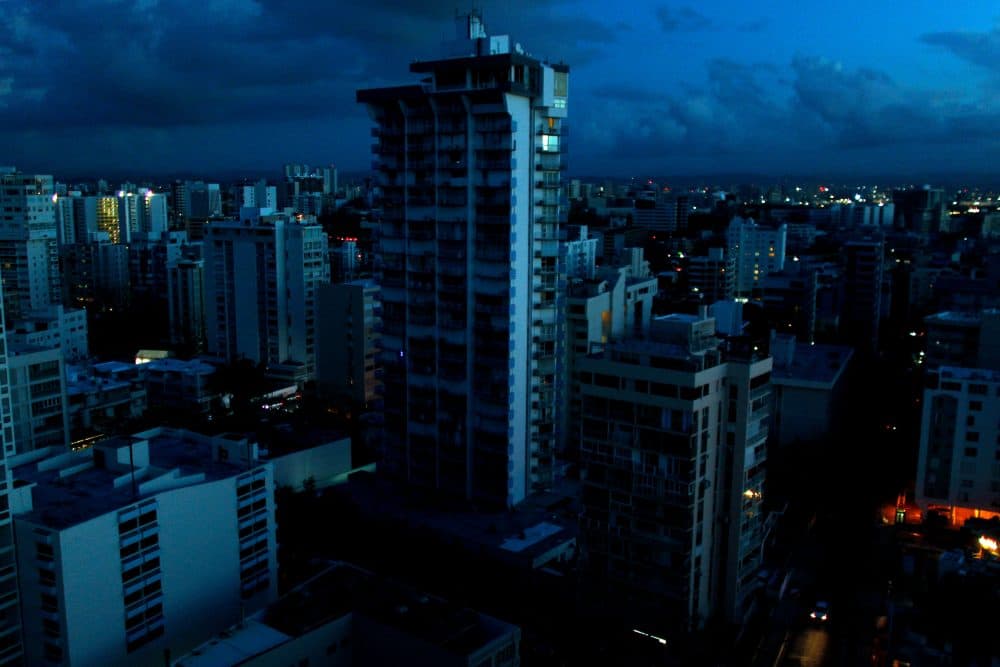Advertisement
Weeks After Hurricane Maria, Puerto Ricans Remain In The Dark
Resume
Two weeks after Hurricane Maria made landfall in Puerto Rico, the vast majority of the island remains without electricity. Authorities say it will take months to fully restore power.
Here & Now's Jeremy Hobson discusses the challenge with José Román Morales, president of Puerto Rico's Energy Commission, and with Gil Quiniones (@GQenergy), president and CEO of the New York Power Authority.
Interview Highlights
What is the state of Puerto Rico's power grid? How many people are still without power?
José Román Morales: Well there's a substantial amount of citizens without power that we're talking about. The latest number that I had [is] up to 90 percent of the island [is] without power.
So millions of people without power still?
Yes, that's correct.
Do you have a sense at this point of how long it's going to take to restore the power?
I'm afraid I don't have an answer to that. I mean the utilities [are] working as vigilantly as possible. The Army Corps of Engineers [is] here, as well as FEMA, and they are all working to energize the island back.
So why did Puerto Rico have such a catastrophic failure of its power grid as a result of Maria?
One thing to always remember [is] that Maria was a very strong hurricane. Now, there were some issues before the hurricane. here were some maintenance issues that PREPA had. For example, there was a lot of backlogs on the tree trimming and obviously, that creates problems. Without a storm, any branch that makes contact with the line will create issues. And with the storm, once the trees start falling or the branches start falling, or the debris starts going everywhere, then you're going to have a problem with the transmission lines as well as the distribution system.
So there's the issue of trees falling on the lines, what about the strength of the winds themselves? Could they have been stronger before the storm?
There was a maintenance issue. PREPA was on the reactive maintenance mode. And not in a proactive maintenance mode — that typically is what you want to be in. The issues with liquidity, issues with personnel, to be able to provide that preventive maintenance. If that would have been implemented on time, it will probably have helped but I do not have the answer because I do not want to presume something that it wasn't a fact.
Do you think that Puerto Rico is going to rebuild its grid in the way that it should rebuild its grid and is going to have the money to do that?
I don't want to get into hypotheticals because right now we are in the face of trying to get on the emergency. The commission is committed to making sure that the grid is built, that it's a modernized grid, that it's a 21st-century grid. That is something the commission is committed to doing and overseeing.
---
You visited Puerto Rico shortly after the devastation caused by Maria. What did you see there, when it comes to the power grid?
Gil Quiniones: We saw a lot of damage mostly on the transmission and distribution system. And you know it's really more stark when you see it in person rather than through TV or cable.
Do you mean basically that there are a lot of power lines down?
Correct. There are a lot of power lines down there are sections of the city that during our visit in San Juan that was completely flooded. We left 10 New York Power Authority experts and two Department of Environmental Conservation drone pilots to help in the damage assessments. Since then Governor Cuomo asked us to add and which we did. We added another 10 experts — generation transmission distribution power experts from the power authority to work side by side with the employees of PREPA, the utility in Puerto Rico, and also lately the U.S. Army Corps of Engineers. So we're a resource, we provide technical operational expertise and troubleshooting expertise to both PREPA and the Army Corps.
How different is what happened in New York after Sandy and what's going on in Puerto Rico post-Maria, when it comes to the power grid?
There are similar things and there are differences. I would say the similar thing for example, Long Island has about three and a half million people also — very similar to Puerto Rico in terms of land area and type of grid. It's very similar. But in New York, we suffered more flooding, coastal flooding, than Puerto Rico. Puerto Rico suffered a lot more wind damage because Maria stayed longer and it was a Category 4 hurricane that kind of lingered and really damaged transmission towers and a lot of distribution poles and substations, etc.
Is there anything that could happen in New York that could cause power to go out for as long as we're seeing in Puerto Rico?
I don't believe so. We have done the hardening and the rebuilding here in New York. Of course, you can never predict [these] severe weather event[s] nowadays. But we have been rebuilding. We have been building our systems back better here in New York so hopefully, we're better prepared.
This article was originally published on October 06, 2017.
This segment aired on October 6, 2017.